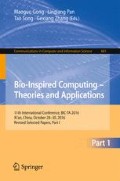Abstract
In this work, we fabricated two logic gates based on circular DNA structure – XOR gate and AND gate calculation model with the principle of complementary base pairing and the technology of fluorescence labeling. Whereafter, we constructed a simple half-adder model based on the two logic gates. This model is simple, but it can realize more complex logic operations in theory. And the experiment process is convenient to operate, the results are easy to realize.
Access this chapter
Tax calculation will be finalised at checkout
Purchases are for personal use only
References
Adleman, L.M.: Molecular computations to combinatorial problems. Sci. New. Ser. 266(5187), 1021–1024 (1994)
Katsikis, G., Cybulski, J.S., Prakash, M.: Synchronous universal droplet logic and control. Nat. Phys. 11(7), 588–596 (2015)
Kramer, B.P., Fischer, C., Fussenegger, M.: BioLogic gates enable logical transcription control in mammalian cells. Biotechnol. Bioeng. 87(4), 478–484 (2004)
Yong, L., Wang, L., Hea, K.: A biomimetic colorimetric logic gate system based on multi-functional peptide-mediated gold nanoparticle assembly. Nanoscale 8(16), 8591–8599 (2016)
Fu, X.F., Sun, W., Guo, R.: Molecular logic function materials. Progr. Chem. 21(5), 957–963 (2009)
Arun, V., Shukla, N.K., Singh, A.K.: Design and performance analysis of multiple all optical logic gates in a single photonic circuit. Opt. Quantum Electron. 48(1), 236–244 (2016)
Bhoj, A.N., Simsir, M.O., Jha, N.K.: Fault models for logic circuits in the multigate era. IEEE Trans. Nanotechnol. 1(11), 182–193 (2012)
Graugnard, E., Kellis, D.L., Bui, H., Barnes, S., Hughes, W.L., Yurke, B.: DNA-controlled excitonic switches. Nano Lett. 12(47), 2117–2122 (2012)
Zhang, C., Wu, L., Yang, J., Liu, S., Xu, J.: A molecular logical switch beacon controlled by thiolated DNA signals. Chem. Commun. 3(49), 11308–11310 (2013)
Shi, X.L., Lu, W., Wang, Z.Y., Pan, L.Q., Cui, G.Z., Xu, J., LaBean, T.H.: Programmable DNA tile self-assembly using a hierarchical sub-tile strategy. Nanotechnology 25(7), 075602 (2014)
Yang, J., Dong, C., Dong, Y.F., Liu, S., Pan, L.Q., Zhang, C.: Logic nanoparticle beacon triggered by the binding-induced effect of multiple inputs. ACS Appl. Mater. Interfaces 6(16), 14486–14492 (2014)
Song, T., Pan, L.: Spiking neural P systems with request rules. Neurocomputing 193(2), 193–200 (2016)
Song, T., Liu, X., Zhao, Y., Zhang, X.: Spiking neural P systems with white hole neurons. IEEE Trans. Nanobiosci. (2016). doi:10.1109/TNB.2016.2598879
Song, T., Pan, Z., Wong, D.M., Wang, X.: Design of logic gates using spiking neural P systems with homogeneous neurons and astrocytes-like control. Inf. Sci. 372, 380–391 (2016)
Wang, X., Song, T., Gong, F., Pan, Z.: On the computational power of spiking neural P systems with self-organization. Sci. Rep. doi:10.1038/srep27624
Shi, X., Wu, X., Song, T., Li, X.: Construction of DNA nanotubes with controllable diameters and patterns by using hierarchical DNA sub-tiles. Nanoscale. doi:10.1039/C6NR02695H
Fan, W.P., Bu, W.B., Shi, J.L.: On the latest three-stage development of nanomedicines based on upconversion nanoparticles. Adv. Mater. 28(21), 3987–4011 (2016)
Vickery, A., Mulholland, A.J., Kamp, V.: On the temperature dependence of enzyme-catalyzed rates. Biochemistry 55(12), 1681–1688 (2016)
Zhang, C., Yang, J., Jiang, S.X., Liu, Y., Yan, H.: DNAzyme-based logic gate-mediated DNA self-assembly. Nano Lett. 16(1), 736–741 (2016)
Jing, Y., Dong, Y.F., Pan, L.Q.: Logic nanoparticle beacon triggered by the binding-induced effect of multiple inputs. ACS Appl. Mater. 6(16), 14486–14492 (2014)
Chen, C.W.: Segmentation of DNA using simple recurrent neural network. Knowl. Based Syst. 1(26), 271–280 (2012)
Xu, J.: Probe machine. IEEE Trans. Neural Netw. Learn. Syst. 27(7), 1405–1416 (2016)
Zhu, Q.C., Liu, G., Kai, M.: DNA aptamers in the diagnosis and treatment of human diseases. Molecules 20(12), 20979–20997 (2015)
Frezza, B.M., Cockroft, S.L., Ghadiri, M.R.: Modular multi-level circuits from immobilized DNA-based logic gates. J. Am. Chem. Soc. 129(48), 14875–14879 (2007)
Zhou, X., Wu, X., Yoon, J.: A dual FRET based fluorescent probe as a multiple logic system. Chem. Commun. (Camb.) 51(1), 111–113 (2015)
Li, W., Zhang, F., Yan, H., Liu, Y.: DNA based arithmetic function: a half adder based on DNA strand displacement. Nanoscale 8(6), 3775–3784 (2016)
Marco, B., Eugenia, O.M.: Programming self-assembly of DNA tiles. Fundamenta Informaticae 143(1–2), 35–49 (2016)
Acknowledgments
This work was supported by the National Natural Science Foundation of China (Grant Nos. 61602424, 61472371, 61472372, 61572446), Basic and Frontier Technology Research Program of Henan Province (Grant No. 142300413214), Program for Science and Technology Innovation Talents in Universities of Henan Province (Grant No. 15HASTIT019), and Young Backbone Teachers Project of Henan province (Grant No. 2013GGJS-106).
Author information
Authors and Affiliations
Corresponding author
Editor information
Editors and Affiliations
Rights and permissions
Copyright information
© 2016 Springer Nature Singapore Pte Ltd.
About this paper
Cite this paper
Cui, G., Wang, X., Zhang, X., Niu, Y., Liu, H. (2016). Logic Gate Based on Circular DNA Structure with Strand Displacement. In: Gong, M., Pan, L., Song, T., Zhang, G. (eds) Bio-inspired Computing – Theories and Applications. BIC-TA 2016. Communications in Computer and Information Science, vol 681. Springer, Singapore. https://doi.org/10.1007/978-981-10-3611-8_5
Download citation
DOI: https://doi.org/10.1007/978-981-10-3611-8_5
Published:
Publisher Name: Springer, Singapore
Print ISBN: 978-981-10-3610-1
Online ISBN: 978-981-10-3611-8
eBook Packages: Computer ScienceComputer Science (R0)

